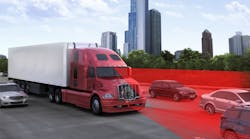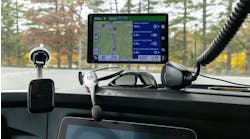The reality of fully autonomous vehicles may still be years away, but OEMs are implementing safety technologies today that brings the industry one step closer. While there are many active safety systems available on vehicles, the two that provide the most autonomy are active steering systems and active braking systems. These systems can work independently or in tandem with one another to help prevent avoidable accidents from occurring.
Active steering systems
An active steering system is most commonly found to work in conjunction with other advanced driver assistance systems (ADAS) on a vehicle, such as lane-keep assist or lane centering. Based on the names of these systems, it may be obvious what they do: keep the vehicle from unintentionally drifting outside of the road lane markings. What may not be so obvious, however, is how these systems bring multiple vehicle components together to perform this task.
Bendix Commercial Vehicle Systems, a developer and supplier of active safety technologies, offers Wingman Fusion, an ADAS for heavy-duty trucks that provides lane keep assist, adaptive cruise control, and automatic emergency braking (AEB), among other features.
“The Fusion system is equipped with a forward-facing camera that provides the active steering system with information such as vehicle positioning,” says TJ Thomas, director of marketing and customer solutions – controls at Bendix. “From there, the active steering system makes calculations to determine how much steering input is needed to stay in its lane of travel. It then uses its torque overlay design to make minor steering adjustments to help the driver keep the vehicle within its current lane of travel.”
As the camera provides the Wingman Fusion system with inputs, the system commands the active steering system to make adjustments to keep the vehicle from drifting across lane markings. The steering system actively adjusts the steering wheel in the driver’s hands and steers the vehicle, though he or she can override it at any time by turning the wheel.
Earlier this year, ZF, a technology company that supplies systems for passenger and commercial vehicles, acquired WABCO, a provider of electronic braking, stability, suspension, and transmission automation systems for commercial vehicles. ZF already had an active steering system available in Europe, and WABCO’s OnGuard active braking system is available worldwide. Now, the company is set to launch a lane-keeping assistance function in North America, says Dan Williams, director, ADAS and autonomy, ZF Commercial Vehicle Technology Division.
“This relatively simple camera-based system is designed to provide and process an indication of vehicle lane position to command a torque input to the handwheel, suggesting [but not demanding] a steering wheel input that prevents a lane departure,” Williams says. “This system can aid the driver to prevent accidents. The camera and computer-controlled steering that comprise this lane-keeping system have been independently available in commercial vehicle production for the past decade.”
Active braking systems
In the way that active steering systems can adjust the direction of the vehicle, active braking systems can adjust the speed and, in certain situations, bring the vehicle to a stop. Active braking systems are typically used in applications such as adaptive cruise control (ACC) and AEB.
An ACC system monitors the road ahead of the truck and adjusts its speed to maintain a set distance from the vehicle in front of it. AEB, on the other hand, monitors for stationary vehicles or objects in the path of the truck.
“The Bendix Wingman Fusion system uses a forward-facing radar, forward-facing camera, and the Bendix ESP full stability system to provide autonomous emergency braking in the commercial vehicle market,” Thomas says. “The radar and camera provide information into the Fusion system algorithms to determine if there is a situation ahead in its lane of travel that may be a potential threat to the vehicle. If so, the Fusion system can then issue a warning to the driver, reduce throttle, apply the engine retarder and, if necessary, apply significant foundation brake force to help mitigate a forward crash.”
Thomas adds that the Fusion system works closely with the ESP brake system in order to help maintain the stability of the vehicle during an AEB event, which is especially important on slippery surfaces.
It is clear there are many systems working closely together to facilitate active braking, so the way they communicate with one another is critical. According to Dirk Wohltmann, engineering, ZF Commercial Vehicle Control Systems Division, the most common signal currently used in active braking systems is the external brake request (XBR). Wohltmann says this type of signal is used for ACC, collision mitigation systems, and other systems requesting a specific deceleration or target vehicle speed.
Though the driver must be alert at all times and is ultimately responsible for avoiding collisions, active braking systems available today are able to mitigate or even prevent some collisions from happening, so it is imperative to ensure active braking systems are inspected and maintained regularly.
Active safety system service and repair
For the most part, keeping active safety systems maintained is simple and straightforward. Fleets are already familiar with inspecting and maintaining braking systems and steering systems, and these systems should continue to be serviced as normal.
Things get somewhat more complicated, however, when it comes to the technological components of active safety systems. The cameras, sensors, and ECUs that do the “seeing” and “thinking” for these systems are more sensitive and require knowledge technicians may not already have. While general training can be helpful here, it is also important for technicians to learn about the specific systems they will be working on; details on how they function, parts and components, diagnosing issues, repairing, and recalibrating.
While active safety system components such as cameras, sensors, and radars should be able to function for the life of the vehicle, ZF’s Williams notes they also require an unobstructed view of the road, making them more vulnerable to accidental damage. In this case, the components will need to be replaced, meaning technicians need to know what the components do and how to service them.
When it comes to servicing the Wingman Fusion, technicians should start by becoming familiar with the Service Data sheets posted on the Bendix.com document library, says Thomas. The Service Data sheets provide detailed instructions on servicing different parts and components within each system.
Thomas also suggests technicians get additional training from Bendix’s video-based online training website, brake-school.com, and learn the software necessary for diagnosing the systems.
“Technicians should become familiar with Bendix ACom PRO diagnostic software, which is capable of providing active and inactive DTCs (diagnostic trouble codes) on the systems, step-by-step troubleshooting actions, BUS statistics, DTC reports, and more,” he says.
In addition to diagnosing system faults, technicians need to be able to recalibrate system components should they require replacement for any reason.
“Replacement parts will need to be carefully mounted and calibrated,” Williams says. “Diagnostic software, such as WABCO Toolbox Plus, can help in servicing and maintaining some of these components.”
Thomas adds that technicians should attend an in-person training demonstration of the safety technologies, if possible. Talking to other fleets who have already implemented these technologies can also help technicians learn best practices on how to maintain and service the systems.
The autonomous future
When it comes to autonomous steering, the mechanical pieces of the puzzle are mostly in place; it is the technology that needs to catch up.
“A steering system that allows the driver to disengage from the driving task must be robust to all the factors that could degrade the function, and this is where the complexity enters,” ZF’s Williams says. “To allow the driver to completely detach from driving, the system would need redundancy and system coordination in sensors and steering actuators. For example, in a rain or snowstorm, additional sensing technologies could be used, such as lidar, accurate GPS and mapping, and V2X and V2V vehicle communication.”
Autonomous braking, on the other hand, may require some fine-tuning both mechanically and technologically before it is ready to take over control of heavy-duty vehicles.
“Today's braking systems use automated braking in rare occasions as most of the braking is done by the driver,” ZF’s Wohltmann says. “But in the autonomous vehicle, automated braking deceleration, precision, consistency, and quality are important in every brake application and the system must be able to react to any situation or scenario.”
Most current North American brake systems use open-loop pressure control, Wohltmann says.
“For the emergency systems and some comfort systems, the open-loop pressure control is precise enough, but there are limitations,” he explains. “Applying a closed-loop pressure control could be the work-around to solve the limitations of an open-loop pressure control which is ‘estimating’ the applied brake pressure and monitoring and controlling the deceleration. Closed-loop pressure control can measure and control the applied brake pressure at each wheel-end. The system can control the pressure precisely towards the target pressure, [which] is calculated based on vehicle-specific brake performance together with the actual loading condition.
“Systems can be designed to control one or all axles with closed-loop pressure control,” Wohltmann adds. “These closed-loop systems are common in electronic braking systems (EBS).”
In his blog post, ADAS and the Pathway to Highly Automated Driving, Bendix’s Thomas agrees that integration of EBS is part of the pathway to more highly automated trucks. He explains that EBS technology allows functions in the brake system to be electronically controlled, as opposed to antilock braking systems (ABS) which use pneumatic signals. He notes that EBS has been used in Europe for two decades, making it a road-tested safety technology.
“More precise controls enable EBS to deliver new brake system features, including smoother braking, and improved brake balance and feel across different load conditions,” Thomas says. “It also allows automated driver-assist features to activate braking more frequently than current ABS systems. More precise control during every brake application – even at the individual axle and wheel-end levels – means the benefits of EBS are realized during automated braking interventions of advanced driver assistance systems.”
This additional technology will no doubt add some complexity to braking system maintenance and repair, but like any field, change is inevitable in vehicle service. Fleets would do well to keep technicians updated and ahead of the curve on training for these systems. While they may just be getting their start on heavy-duty commercial vehicles now, active safety systems are almost certain to become more prevalent soon.




